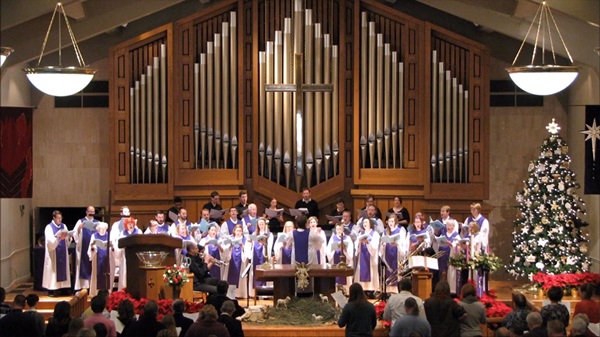Increasingly over the past four decades, United Methodist congregations with choirs have included a service of “Lessons and Carols” among their Advent or Christmas musical celebrations. The United Methodist forms of this service, modeled on “A Festival of Nine Lessons and Carols” held annually at King’s College in Cambridge, England since 1918, may be found in United Methodist Book of Worship, both in its original form for Christmas, and, for Advent, “An Advent Service of Lessons and Carols,” with seven different readings focused primarily on Christ’s second coming.
The appeal of the service, as well as its increasing prevalence, is likely the music. During the lead-up to Christmas or Christmas season itself, It is a joy to be part of celebration that involves both familiar and new music performed by a choir as well as plenty of opportunity for robust congregational singing. The service also gives choirs a sizeable repertoire of songs they can sing again during Advent or Christmas Season.
That the service, as such, is only a little over a century old may come as a surprise to some, as it may seem to be a much older, even ancient tradition in some ways.
And, indeed, in its basic form, it is.
It is an adaptation by the Dean of King’s College, The Very Rev. Eric Milner-White, of one of the forms of a “Vigil” service. A Vigil is a service held very late at night or in the pre-dawn hours. Egeria, a fourth century Spanish pilgrim to Jerusalem, described one of the the pre-dawn Sunday vigil services she experienced there. She reported it as as a continuing series of spoken hymns and antiphons, both composed of scripture texts, with prayers set between them.
This structure also became the pattern the Service of the Word in the Great Vigil of Easter (United Methodist Book of Worship, pp. 373-375). In both the Great Vigil and the Service of Lessons and Carols, there is a an underlying pattern of scripture reading followed by a psalm, hymn, or choral work. In the Easter Vigil, a prayer follows the song as well. In both, the pattern Is repeated multiple times (at least three times for the Hebrew Scripture readings of the Easter Vigil, seven for the Advent version, nine for Christmas). And in both the Easter Vigil and Lessons and Carols, the readings from the Hebrew and Christian scriptures are selected to recount the history of salvation, beginning with creation. For the Easter Vigil, the readings conclude with one of the resurrection narratives from the synoptic gospels. For the Service of Nine Lessons and Carols, the service concludes with several of the stories of Christ’s birth from Luke and Matthew and the prologue of John’s gospel reflecting on the mystery of the incarnation. And for the Service of Advent Lessons and Carols, the final reading is the declaration of the nearness of God’s kingdom by John the Baptist and Jesus from Mark 1.
While the music may be what draws us to services of Lessons and Carols, what actually drives the vigil form of worship historically is an extended period of listening to the scriptures. The bidding prayer at the beginning of the Christmas version of the service, spoken by the pastor, alludes to this:
“Beloved in Christ,
this Christmas Eve (Day, Season ) it is our duty and delight
to prepare ourselves to hear again the message of the angels,
and to go in heart and mind to Bethlehem,
and see this thing which is come to pass,
and the Babe lying in a manger.”
The emphasis is on hearing the message and engaging with the story of the scriptures. The music is intended to be selected to enhance meditation on each scripture.
Whenever a congregation offers a service of Lessons and Carols, it is engaging in an ancient pattern of Christian worship intended to help its participants spend extended time together in meditation on the Scriptures.
If your congregation does not offer Lessons and Carols in some form, consider finding one in your area that does, and plan to attend it. Go for the music, but stay focused on the scriptures, and let them both abide with you through the season that follows.
Burton Edwards is director of Ask The UMC, the information service of United Methodist Communications.





